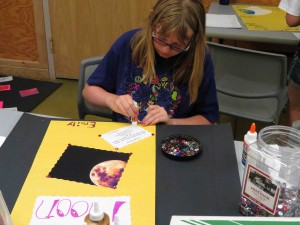Capturing the Cosmos in College Park
Special thanks to our guest blogger, Chelsea Dorman, College Park Aviation Museum, College Park, MD for this post
Last fall, College Park Aviation Museum had the opportunity to lead two Capture the Colorful Cosmos classes using assistance from a Smithsonian Youth Access Fund grant. Our museum attracts many younger children for all of its hands-on activities, but we have been looking for ways to expand our reach to older students. I was excited to be able to use a program about astrophotography to target a new audience of middle school age students. With events like the transit of Venus and solar flares frequently making the news, learning to operate robotic telescopes to take pictures of the heavens has an easy draw. College Park sits just outside of Washington, D.C. in Prince George’s County, MD and boasts a very diverse population. The Maryland-National Capital Parks and Planning Commission runs much of the recreation in the county including 41 community centers and our museum. This made it a natural fit for us to offer the Capture the Colorful Cosmos program to our immediate community.
We decided to hold our Capture the Colorful Cosmos programs at nearby community centers since the museum does not have a computer lab. Both Beltsville Community Center and Langley Park Community Center offered us space for an after school program that would be held once a week, for six weeks in their computer labs. Our class size was limited to 10 students by the seats available in the room, but we found that these students kept us busy throughout each class, and it would have been difficult to accommodate additional participants.
In our first session, students learned the basics of the MicroObservatory software, how to request images, and discussed how astronomy influences their everyday life. Throughout the course we tried to keep a balance of learning to manipulate images, learning about the universe, and a creative activity. At the end of each session students went home with a copy of the image they had created that day printed on our photo printer. By the end of the course, students were able to create and refine composite images and false color images, creating all sorts of artistic, brightly colored galaxies and moons. The Kids Capture the Universe curriculum provided by the Harvard-Smithsonian Center for Astrophysics was a terrific resource for finding activities and planning our program. One of our students’ favorite activities was creating astropoetry and many of them decided to include their poem in our final exhibit.
All of the students’ hard work culminated in an exhibit that was displayed at College Park Aviation Museum for three months. Each student picked two images they had created to display. During our final two classes, everyone poured through books and websites to learn about the celestial objects in their images so they could write a caption describing their work. The exhibit was debuted with an evening reception, which coincided with the opening of our Aviation Meets Art exhibit featuring local artists. It was a fantastic event, and everyone was thrilled and impressed by what the kids had created. In fact, many of the adults in attendance wanted to know when they would have their chance to create astrophotography images of their own.
The Capture the Colorful Cosmos program has been a great way for us to continue to grow our outreach. Through this program we were able to reach a nearby home-school group who had never been to our museum. The kids had a lot of enthusiasm for what they were learning, and would frequently share other astrophotography pictures and facts they had found at home. The program was a great success, and we plan on using what we have learned to host another workshop, this time at College Park Aviation Museum. In May, we will utilize the set of netbooks made available by the Harvard-Smithsonian Center for Astrophysics to host a family workshop. We hope this will allow the younger children and adults who are interested to learn about astrophotography too. Capture the Colorful Cosmos was easy to learn and implement, so we hope to continue offering it as a recurring event.




 Smithsonian Immigration/Migration Initiative (SIMI)
Smithsonian Immigration/Migration Initiative (SIMI)








